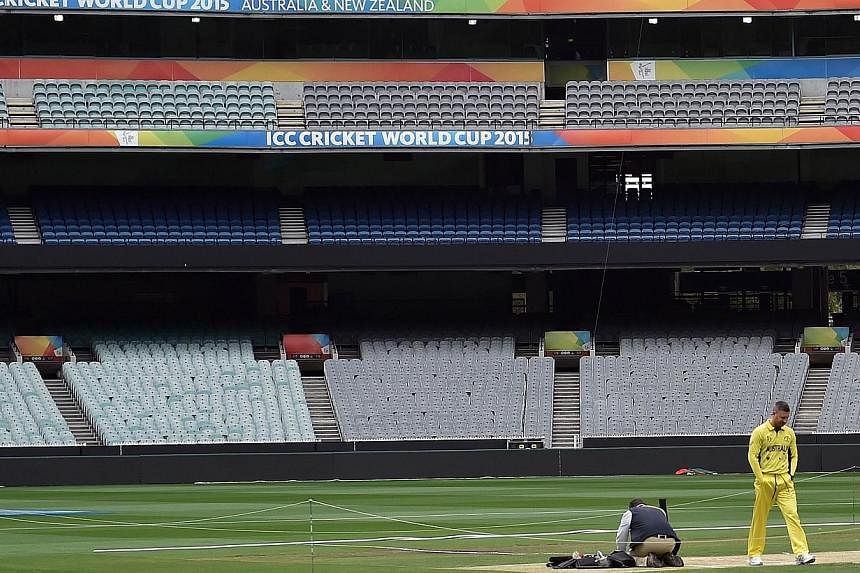WHETHER or not size really does matter will be put to the test on Sunday.
Opinions in this case are divided purely along the lines of national identity. Michael Clarke's Australians reckon it does matter. Brendon McCullum's New Zealanders, on the other hand, scoff at that idea.
Of course, we're talking about the size of the arena on which the World Cup final is to be played.
The historic Melbourne Cricket Ground, known as the MCG - or simply the 'G' to most cricket fans - is the sold-out venue and the debate centres on whether its long boundaries, rather than just a basic home-ground advantage, will put a dampener on New Zealand's big-hitting batsmen who have played all their earlier games in this tournament on their own, smaller grounds.
When the first World Cup was played 40 years ago, a run rate of six an over was considered a psychological barrier because it denoted one run off every ball.
However, like the symbolic four-minute mile, that has long been discarded on the back of an attacking spirit honed by both a surfeit of one-day internationals and Twenty20 games, as well as a quantum leap in the definition of attacking cricket.
There is another key difference to consider. Back in 1975, when the Cup was played for the first time, each nation simply picked its five-day Test side to play the inaugural one-day world championship. Now, of course, Test players are not automatically included in one-day sides but are routinely replaced by an endless treadmill of ODI specialists.
Logically, therefore, it follows that a run a ball is no longer daunting to the present generation of one-day players, but even with that in mind, consider the following figures from New Zealand's semi-final win against South Africa.
Despite facing the formidable Dale Steyn with the new ball, the home team were 26 for no loss after just two overs, or an average of 13 runs an over. After four overs, they were 46 without loss. Then, at the end of the fifth over, they had 71 on the board, a rate of more than 14 an over.
New Zealand captain Brendon McCullum, who scored a blistering 26-ball 59 in that game, has by far the highest strike rate in this tournament. At 191.81, he is streets ahead of any of the Australians. Even the Australian improviser Glenn Maxwell has a strike rate of 182.02, followed by his team-mate Brad Haddin with 157.50.
It is McCullum and his chief standover men - Martin Guptill and Grant Elliott - who hold the key to New Zealand's work rate, whether setting a target for Clarke's men or chasing down an Australian total under the 30-year-old light towers at the MCG.
Victory today would give New Zealand a second major sporting crown, for they already hold the rugby union World Cup, which the All Blacks won dramatically in October 2011, beating France by a single point.
Yet the cricket World Cup represents a fresh challenge as the Black Caps - losing semi-finalists in six previous World Cups - had never been in a final until they beat South Africa with just one ball to spare at Auckland's Eden Park on Tuesday.
For Michael Clarke - playing his last ODI today - there is the chance to book-end his World Cup career in an appropriately dominant manner.
In the 2007 tournament, his first World Cup, he was the pre-eminent batsman, scoring 436 runs at an average of 87.2. Having announced that this final will be his last limited-overs game, he now has the chance to join only three other men - Allan Border, Steve Waugh and Ricky Ponting - who have led Australian to a World Cup title.
But in this, the first trans-Tasman final in the tournament's history, perhaps there is even more at stake for McCullum. Long regarded as one of the most destructive batsmen in limited-overs cricket, he has the hopes of a nation riding on his broad shoulders.
On paper at least, New Zealand have the edge over Australia if the tournament stats are to have a flow-on effect at the MCG. They have the tournament's highest scorer (Martin Guptill, with 237 not out); the leading wicket-taker (Trent Boult with 21 scalps so far) and the best individual bowling figures (Tim Southee's 7-33 against England).
In truth, though, previous stats will have less relevance than the toss in today's World Cup final.
What will be extremely interesting is the tactical possibililty of a follow-up to a couple of revealing passages of play in earlier games.
On the one hand, New Zealand's bowlers will have noted the unsettling effect of searing, sustained bowling delivered to Australia's Shane Watson by Pakistan's Wahab Riaz, whose spell of deliveries aimed in the area between rib cage and head caused the batsman several moments of discomfort before he finally broke loose.
And on the other hand, Clarke would have noted a key period in the NZ-South Africa semi-final when a single over in Dale Steyn's opening spell was carted for 25 runs. It is a fair bet that his bowlers have studied that footage more than once to ensure that they starve the opposing batsmen of width and height.
There is another thing to bear in mind. Based on the fact that the opposing sides have no discernible achilles heel/s, the corollary therefore is that this World Cup final should provide a sustained quality like no other in history.
If you, like me, are flummoxed about which side to pick today, there is probably an easier bet to place. There is a fair chance that today's game will be the first World Cup final with 600 runs or more. You might not get great odds from a bookie because of the strength of the respective batting line-ups, but remember - size isn't everything.


